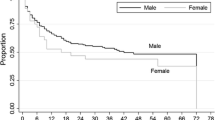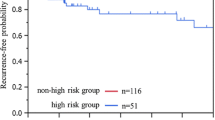Abstract
Primary spontaneous pneumothorax (PSP) is not uncommon, and its recurrence is often a challenging clinical problem. Surgical management and predisposing factors for the recurrence of PSP, however, have not yet been well elucidated in adolescent patients. The major aim of this study was to investigate factors associated with proceeding to surgical intervention and recurrence of PSP in adolescents. Two hundred and nineteen episodes of PSP in 171 adolescent patients were retrospectively reviewed. The clinical and radiological spectrum of PSP and factors for proceeding to surgical intervention were assessed in these 171 patients. Risk factors for the recurrence of PSP were further analyzed in 128 patients with first attack of PSP. The male-to-female ratio of the 171 PSP patients was 9:1, and the mean age was 17.6 ± 1.5 years. The median body mass index (BMI) percentile was 11 (range 2–31), and 45 (34 %) patients had underweight BMI. The incidence of recurrent PSP was high with a total recurrence rate of 21 %. Ipsilateral recurrence rate of PSP after video-assisted thoracoscopic surgery (VATS) was much less than that of the conservative treatment (4 vs. 18 %). A large-size pneumothorax with a persistent air leak was the most significant factor for proceeding to VATS surgery (P = 0.001). In addition, it was a significant factor influencing the recurrence of PSP (P = 0.014). Other factors that did not significantly affect the recurrence rate were BMI, smoking status, and the number of bullae. Conclusion: Adolescent PSP has a high recurrence rate of 21 % after a 2-year follow-up. A large-size pneumothorax with a persistent air leak may not only lead to surgical intervention but also the risk of a recurrence of PSP. The initial size of pneumothorax may not only guide the management process but also predict the risk of a recurrence in adolescent patients with PSP.


Similar content being viewed by others

Abbreviations
- BMI:
-
Body mass index
- CXR:
-
Chest X-ray
- HRCT:
-
High-resolution computed tomography
- PA:
-
Posteroanterior
- PSP:
-
Primary spontaneous pneumothorax
- VATS:
-
Video-assisted thoracoscopic surgery
References
Baumann MH, Strange C, Heffner JE, Light R, Kirby TJ, Klein J, Luketich JD, Panacek EA, Sahn SA (2001) Management of spontaneous pneumothorax: an American College of Chest Physicians Delphi consensus statement. Chest 119(2):590–602
Bense L, Eklund G, Wiman LG (1987) Smoking and the increased risk of contracting spontaneous pneumothorax. Chest 92(6):1009–1012
Butterworth SA, Blair GK, LeBlanc JG, Skarsgard ED (2007) An open and shut case for early VATS treatment of primary spontaneous pneumothorax in children. Can J Surg 50(3):171–174
Chan SS (2004) Estimation of size of pneumothorax under the new BTS guidelines. Thorax 59(4):356, author reply 356–357
Cheng YL, Huang TW, Lin CK, Lee SC, Tzao C, Chen JC, Chang H (2009) The impact of smoking in primary spontaneous pneumothorax. J Thorac Cardiovasc Surg 138(1):192–195. doi:10.1016/j.jtcvs.2008.12.019
Chou SH, Li HP, Lee JY, Chang SJ, Lee YL, Chang YT, Kao EL, Dai ZK, Huang MF (2010) Is prophylactic treatment of contralateral blebs in patients with primary spontaneous pneumothorax indicated? J Thorac Cardiovasc Surg 139(5):1241–1245. doi:10.1016/j.jtcvs.2009.07.047
Cook CH, Melvin WS, Groner JI, Allen E, King DR (1999) A cost-effective thoracoscopic treatment strategy for pediatric spontaneous pneumothorax. Surg Endosc 13(12):1208–1210
Deslauriers J, Beaulieu M, Despres JP, Lemieux M, Leblanc J, Desmeules M (1980) Transaxillary pleurectomy for treatment of spontaneous pneumothorax. Ann Thorac Surg 30(6):569–574
Hirai S, Hamanaka Y, Mitsui N, Morifuji K, Uegami S, Matsuura Y (2007) Therapeutic strategy for spontaneous pneumothorax. Kyobu Geka 60(3):175–179, discussion 179–182
Huang TW, Lee SC, Cheng YL, Tzao C, Hsu HH, Chang H, Chen JC (2007) Contralateral recurrence of primary spontaneous pneumothorax. Chest 132(4):1146–1150. doi:10.1378/chest.06-2772
Kallstrom TJ (2002) AARC Clinical Practice Guideline: oxygen therapy for adults in the acute care facility—2002 revision & update. Respir Care 47(6):717–720
Luh SP (2010) Review: diagnosis and treatment of primary spontaneous pneumothorax. J Zhejiang Univ Sci B 11(10):735–744. doi:10.1631/jzus.B1000131
MacDuff A, Arnold A, Harvey J (2010) Management of spontaneous pneumothorax: British Thoracic Society Pleural Disease Guideline 2010. Thorax 65(Suppl 2):ii18–ii31. doi:10.1136/thx.2010.136986
Melton LJ 3rd, Hepper NG, Offord KP (1979) Incidence of spontaneous pneumothorax in Olmsted County, Minnesota: 1950 to 1974. Am Rev Respir Dis 120(6):1379–1382
Mitlehner W, Friedrich M, Dissmann W (1992) Value of computer tomography in the detection of bullae and blebs in patients with primary spontaneous pneumothorax. Respiration 59(4):221–227
Neal JF, Vargas G, Smith DE, Akl BF, Edwards WS (1979) Bilateral bleb excision through median sternotomy. Am J Surg 138(6):794–797
Noppen M (2010) Spontaneous pneumothorax: epidemiology, pathophysiology and cause. Eur Respir Rev 19(117):217–219. doi:10.1183/09059180.00005310
Ogden CL, Kuczmarski RJ, Flegal KM, Mei Z, Guo S, Wei R, Grummer-Strawn LM, Curtin LR, Roche AF, Johnson CL (2002) Centers for Disease Control and Prevention 2000 growth charts for the United States: improvements to the 1977 National Center for Health Statistics version. Pediatrics 109(1):45–60
Ozcan C, McGahren ED, Rodgers BM (2003) Thoracoscopic treatment of spontaneous pneumothorax in children. J Pediatr Surg 38(10):1459–1464
Poenaru D, Yazbeck S, Murphy S (1994) Primary spontaneous pneumothorax in children. J Pediatr Surg 29(9):1183–1185
Primrose WR (1984) Spontaneous pneumothorax: a retrospective review of aetiology, pathogenesis and management. Scott Med J 29(1):15–20
Qureshi FG, Sandulache VC, Richardson W, Ergun O, Ford HR, Hackam DJ (2005) Primary vs delayed surgery for spontaneous pneumothorax in children: which is better? J Pediatr Surg 40(1):166–169. doi:10.1016/j.jpedsurg.2004.09.042
Robinson PD, Cooper P, Ranganathan SC (2009) Evidence-based management of paediatric primary spontaneous pneumothorax. Paediatr Respir Rev 10(3):110–117. doi:10.1016/j.prrv.2008.12.003, quiz 117
Sadikot RT, Greene T, Meadows K, Arnold AG (1997) Recurrence of primary spontaneous pneumothorax. Thorax 52(9):805–809
Shiwaku K, Anuurad E, Enkhmaa B, Kitajima K, Yamane Y (2004) Appropriate BMI for Asian populations. Lancet 363(9414):1077. doi:10.1016/s0140-6736(04)15856-x
Sihoe AD, Yim AP, Lee TW, Wan S, Yuen EH, Wan IY, Arifi AA (2000) Can CT scanning be used to select patients with unilateral primary spontaneous pneumothorax for bilateral surgery? Chest 118(2):380–383
Smit HJ, Wienk MA, Schreurs AJ, Schramel FM, Postmus PE (2000) Do bullae indicate a predisposition to recurrent pneumothorax? Br J Radiol 73(868):356–359
Stradling P, Poole G (1966) Conservative management of spontaneous pneumothorax. Thorax 21(2):145–149
Uramoto H, Shimokawa H, Tanaka F (2012) What factors predict recurrence of a spontaneous pneumothorax? J Cardiothorac Surg 7:112. doi:10.1186/1749-8090-7-112
Wang CS, Chou P (1996) The prevalence and motivating factors of adolescent smoking at a rural middle school in Taiwan. Subst Use Misuse 31(10):1447–1458
Wen CP, Levy DT, Cheng TY, Hsu CC, Tsai SP (2005) Smoking behaviour in Taiwan, 2001. Tob Control 14(Suppl 1):i51–i55. doi:10.1136/tc.2004.008011
Conflict of interest
This work was supported by CMRPG2B0391 from the Chang Gung Medical foundation, Chang Gung University, Taiwan. The authors report no conflicts of interest or any financial relationship with the organization that sponsored this research and are responsible for the content and writing of the paper.
Author information
Authors and Affiliations
Corresponding author
Additional information
Communicated by Peter de Winter
Rights and permissions
About this article
Cite this article
Chiu, CY., Chen, TP., Wang, CJ. et al. Factors associated with proceeding to surgical intervention and recurrence of primary spontaneous pneumothorax in adolescent patients. Eur J Pediatr 173, 1483–1490 (2014). https://doi.org/10.1007/s00431-014-2352-0
Received:
Revised:
Accepted:
Published:
Issue Date:
DOI: https://doi.org/10.1007/s00431-014-2352-0



